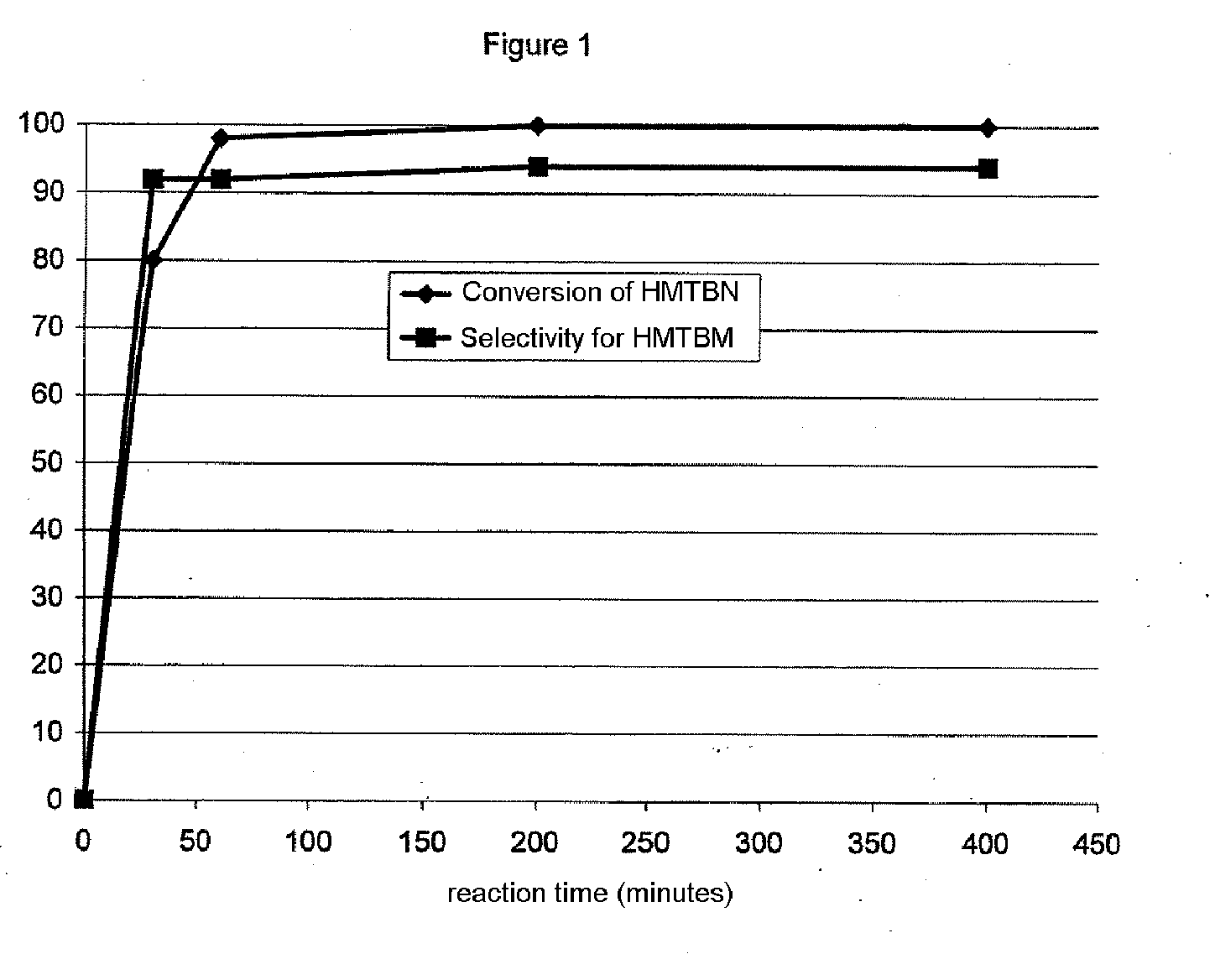Method for the catalytic conversion of 2-hydroxy-4-methylthiobutanenitrile (HMTBN) into 2-hydroxy-4-methylthiobutanamide (HMTBM)
a technology of methylthiobutanenitrile and catalytic conversion, which is applied in the direction of metal/metal-oxide/metal-hydroxide catalyst, asymmetric synthesizer, sulfide preparation, etc., can solve the problem of difficult extraction of inorganic products, difficult synthesizing enzymes and extracting, and inability to control selectivity, etc. problem, to achieve the effect of limiting the formation of unwanted by-products, shor
- Summary
- Abstract
- Description
- Claims
- Application Information
AI Technical Summary
Benefits of technology
Problems solved by technology
Method used
Image
Examples
example 1
Preparation of a Catalyst A
[0064]A formulated catalyst having a composition of 90% by weight of cerium oxide and 10% by weight of alumina is prepared by wet granulation.
[0065]To prepare this catalyst, a cerium oxide from Rhodia, HSA-5, and an alumina SB3 from Condea and water as binder are used.
[0066]A mixture of powders composed of 90% by weight of cerium oxide and 10% by weight of alumina is prepared. 10% by weight of initiators for this composition are prepared in a granulating dish. The mixture of powders is then continuously introduced slowly, and the water is simultaneously sprayed in order for the granulation to be effective. The granules produced are “selected naturally by centrifugation”, said granules being removed from the dish as soon as the particle size is reached (4-5 mm), via the speed of rotation and incline of the dish.
[0067]They are recovered, dried in an oven for 12 h at 60° C. and then calcined for 2 h at 500° C.
example 2
Preparation of a Catalyst B
[0068]A formulated catalyst having a composition of 90% by weight of alpha manganese oxide and 10% by weight of alumina is prepared by extrusion.
[0069]To prepare this catalyst, an HSA alpha manganese oxide from Comilog (batch no. 103514-12) and an alumina SB3 from Condea are used.
[0070]The “90% by weight of alpha manganese oxide” and “10% by weight of alumina” powders are mixed.
[0071]67 g of a mixture of powders are introduced into a Brabender kneading machine and 32 ml of purified water are introduced over 8 minutes. The kneading time after the introduction of water is 20 minutes. The paste obtained is then introduced into the 1.5 mm multi-hole die. The spaghetti strings generated are smooth and break easily. They are dried in an oven at 60° C. for 18 hours. These dry spaghetti strings are then calcined at 400° C. then stages of 2 hours.
[0072]The extruded materials thus obtained after calcination have lengths which range between 3 and 20 mm.
example 4
Hydration of 2-hydroxy-4-methylthiobutanenitrile to 2-hydroxy-4-methylthiobutanamide in the Presence of the Powder Catalysts A, B and C
[0075]This example gives the results of measuring the conversion of 2-hydroxy-4-methylthiobutanenitrile in the presence of the compositions of the previous examples and in the manner which follows.
[0076]5 g of compound according to one of the examples above are ground and screened so as to recover the particle size fraction between 100 and 200 μm.
[0077]0.6 g of this particle size fraction is introduced into a Schott tube. The reaction mixture, composed of a solution of 23% by weight of HMTBN in water, is introduced into the Schott tube containing the catalyst. A magnetic bar is then placed in the Schott tube and stirred so as to homogenize the reaction mixture.
[0078]The Schott tube thus loaded is then heated to 75° C. The initial reaction time is considered to be when the temperature of 75° C. has been reached.
[0079]After reaction for 60 minutes, the...
PUM
| Property | Measurement | Unit |
|---|---|---|
| temperature | aaaaa | aaaaa |
| temperature | aaaaa | aaaaa |
| temperature | aaaaa | aaaaa |
Abstract
Description
Claims
Application Information
 Login to View More
Login to View More - R&D
- Intellectual Property
- Life Sciences
- Materials
- Tech Scout
- Unparalleled Data Quality
- Higher Quality Content
- 60% Fewer Hallucinations
Browse by: Latest US Patents, China's latest patents, Technical Efficacy Thesaurus, Application Domain, Technology Topic, Popular Technical Reports.
© 2025 PatSnap. All rights reserved.Legal|Privacy policy|Modern Slavery Act Transparency Statement|Sitemap|About US| Contact US: help@patsnap.com


